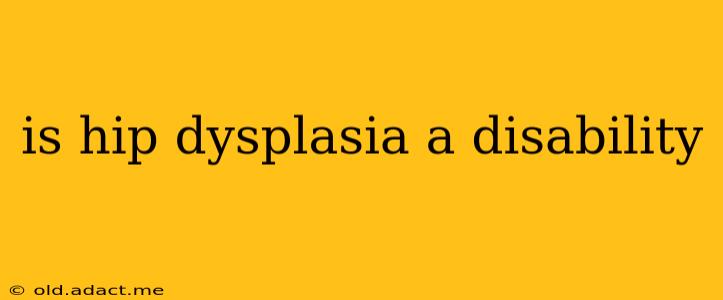Hip dysplasia, a condition where the hip joint doesn't develop properly, can significantly impact a person's life. Whether or not it constitutes a disability depends on several factors, making it a complex issue without a simple yes or no answer. This article delves into the complexities of hip dysplasia and its potential classification as a disability.
What is Hip Dysplasia?
Hip dysplasia is a developmental condition affecting the hip joint. In individuals with hip dysplasia, the ball (femoral head) and socket (acetabulum) of the hip joint don't fit together correctly. This misalignment can lead to a range of symptoms and complications, varying greatly in severity from person to person. Some individuals may experience minimal discomfort, while others face severe pain and mobility limitations.
Can Hip Dysplasia Qualify for Disability Benefits?
The determination of whether hip dysplasia qualifies for disability benefits depends heavily on the individual's specific circumstances and the impact of the condition on their daily life. Several factors are considered:
-
Severity of Symptoms: Mild hip dysplasia might not significantly impact daily activities, while severe dysplasia can cause chronic pain, limited mobility, and difficulty performing essential tasks. The severity of the condition directly influences the assessment.
-
Impact on Daily Activities: Disability assessments focus on how the condition affects a person's ability to perform daily activities such as walking, standing, sitting, dressing, and bathing. Significant limitations in these areas are key factors in determining eligibility.
-
Treatment Response: The effectiveness of treatments, including physical therapy, medication, and surgery, is also considered. If treatment significantly improves function, it might reduce the likelihood of disability classification.
-
Age: The age of onset and the progressive nature of the condition play a role. Hip dysplasia diagnosed in early childhood may require more extensive intervention and ongoing management compared to later-onset cases.
-
Occupation: The type of work a person performs significantly influences disability assessments. Individuals in physically demanding jobs may find it more challenging to continue working with hip dysplasia than those in sedentary roles.
How is Hip Dysplasia Diagnosed?
Diagnosis typically involves a physical examination, where a doctor assesses the range of motion and stability of the hip joint. Imaging techniques such as X-rays and ultrasounds are crucial for visualizing the hip joint and confirming the diagnosis.
What are the Treatment Options for Hip Dysplasia?
Treatment approaches vary depending on the severity and the individual's age. Options range from conservative measures such as physical therapy and bracing to surgical interventions like hip reduction or replacement. Early diagnosis and timely intervention are often key to improving outcomes.
Is Hip Dysplasia Considered a Disability Under the ADA?
The Americans with Disabilities Act (ADA) defines disability broadly, encompassing physical impairments that substantially limit one or more major life activities. Severe hip dysplasia can certainly fall under this definition, but eligibility is determined on a case-by-case basis, considering the individual's specific situation.
What are the Long-Term Effects of Hip Dysplasia?
Long-term effects vary widely depending on the severity of the condition and the effectiveness of treatment. Untreated or severely affected individuals may experience chronic pain, osteoarthritis, and significant mobility limitations. With proper diagnosis and treatment, many individuals can maintain a relatively high quality of life.
Conclusion: A Case-by-Case Determination
Ultimately, whether hip dysplasia is considered a disability is a case-by-case determination. The severity of the condition, its impact on daily life, and the response to treatment all play significant roles in this assessment. Individuals experiencing difficulties due to hip dysplasia should consult with medical professionals and disability experts to determine their eligibility for disability benefits or accommodations under the ADA.
